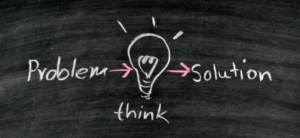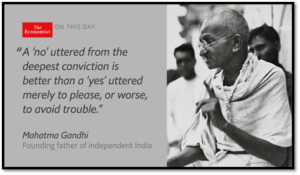
Last year The Economist decided to invest significantly in social media. One year later Denise Law, Community Editor at The Economist analyses the results and shares with us eight lessons they learned from that experience.
The Economist started by expanding the social media team from 2 to 10 people. The main objective of that investment was to find new subscribers. The results are very impressive so far as they consider having increased their digital subscriptions by 31% thanks to that effort.
Let us discover the eight most important lessons they learned.
-
Identify your problems and build a strategy that solves them
 The Economist faced two problems when trying to attract new subscribers. The first is that not enough people knew the newspaper. According to the Pew Research Center, 60% of Americans had never heard of The Economist. The second is that many of them wrongly associated the newspaper only with economics and finance while they have been writing about a much broader range of topics (politics, culture,..) since they were founded in 1843.
The Economist faced two problems when trying to attract new subscribers. The first is that not enough people knew the newspaper. According to the Pew Research Center, 60% of Americans had never heard of The Economist. The second is that many of them wrongly associated the newspaper only with economics and finance while they have been writing about a much broader range of topics (politics, culture,..) since they were founded in 1843.
Social media was one of the best means to solve those two issues. It enabled them to recreate awareness about the brand and to make their name associated with the right concept among many potential readers.
-
Know your target audience and tailor your product to them
The Economist made extensive internal research and defined their targeted readers: the globally curious, the “progressive ones”. Having that information, helped the team adapt their social media strategy to find the right readers and deliver them the right content.
The social media team understood that identifying their target audience was important to make their communication effective. It enabled them to present themselves clearly and prevented them from dumbing down their image.
-
Use data to deny and confirm your assumptions. Prioritise ruthlessly
According to Denise Low data helped them understand how they shloud interact with their audience across the different social media platforms available. It enabled them to make the right decisions.
 The team hired a data scientist who determined where to focus in order to reach the right persons. For instance, they discovered that they spent too much time using their different Twitter accounts which generated little traffic and engagement. They then decided to reallocate a part of that energy to other platforms such as LinkedIn and Line. They also decided to experiment storytelling formats on Facebook and on their main Twitter account. This resulted in a much more effective communication and return.
The team hired a data scientist who determined where to focus in order to reach the right persons. For instance, they discovered that they spent too much time using their different Twitter accounts which generated little traffic and engagement. They then decided to reallocate a part of that energy to other platforms such as LinkedIn and Line. They also decided to experiment storytelling formats on Facebook and on their main Twitter account. This resulted in a much more effective communication and return.
-
Experiment, measure and learn
The team discoverd that the best way to innovate was to experiment. Instead of long meetings, they started organizing short sessions focusing on developing an idea and figuring out how to make it happen.
 With the help of data analysis they then took a look at whether the experiment met or not the objectives. If it was successfull they tested it again several times before officially launching it in the workflow. This process has allowed them to develop and use new format concepts such as On This Day Cards.
With the help of data analysis they then took a look at whether the experiment met or not the objectives. If it was successfull they tested it again several times before officially launching it in the workflow. This process has allowed them to develop and use new format concepts such as On This Day Cards.
-
Tear down the walls between departments
The social media team figured out that It was important to enable the different teams to interact with each others. This is the reason why they decided to remove the walls between several offices to create an open space where skills were combined. This way, social media writers, developers, data analysts and marketing colleagues could share their ideas and put the readers at the heart of what they did.
-
Always choose quality over quantity
The Economist knew that the image people have of your brand is extremely important. This is indeed one of the main reasons why The Economist decided to put a massive effort in social media. But playing with the brand image is dangerous if not well managed.
When they started their social media project in the summer 2015 their main priority was growth. Their desire to catch as many new readers as possible made them post more and more content more frequently. Fortunately they realised quite fast that this behaviour could damage their brand.
 They then decided to refocus on the quality of their output instead of quantity. This strategy enabled them to be in phase with the image they wanted to show and to reach the right audience.
They then decided to refocus on the quality of their output instead of quantity. This strategy enabled them to be in phase with the image they wanted to show and to reach the right audience.
Before publishing something they now ask themselves “does this piece of social media journalism make someone feel smarter?” and they only publish it if the answer is yes.
-
Do things, show people
Sharing results with colleagues from other departments turned out to be crucial as it brought very valuable feedback.
Building a brand image doesn’t only count for external users. Sharing with internal teams helped The Economist grow their brand as a whole.
-
Involve journalists in the workflow
A step further was to involve journalists as much as possible in the social media publications. The social media team tried first to involve the editorial department by asking them to check the posts before publishing them on social media. The goal was to make sure it accurately represented the newspaper spirit.
As a result, many journalists even sent suggestions to the social media team. All those contributions enabled the social media team to produce a better work.
“This process enables everyone to learn together.”
Main Source: “The eight lessons we learned – Social media team : one year later”. Denise Low, Community Editor at The Economist.
You will find the full article of Denis Law here
